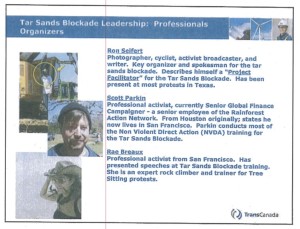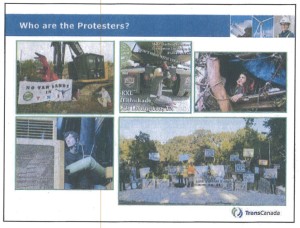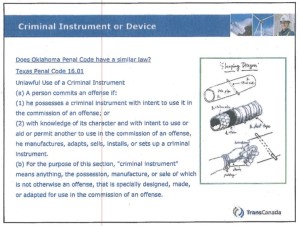Saturday, June 15, 2013
TransCanada Is Secretly Briefing Police About Keystone XL Protests and Urging Terrorism Prosecutions
by Will Potter, "Red Is The New Green," June 12, 2013

New documents show that TransCanada, the corporation behind the $5.3 billion Keystone XL oil pipeline, has been briefing police about non-violent protesters and urging prosecutors to consider them “terrorists.”
Environmentalists have waged a diverse campaign against the 2,000-mile pipeline that has included civil disobedience at the White House, tree sits and blockades, and a new lawsuit by the Sierra Club saying the U.S. State Department’s environmental review of the Keystone XL is “plagued by conflicts of interest.”
The tactics are working. In response, TransCanada is filing lawsuits across the country in hopes of deterring opposition; in Oklahoma, they recently filed a restraining order against protesters.
New documents show that TransCanada is also working behind the scenes with local police, providing cops with names and photographs of dozens of activists, warning of non-violent tactics, and urging terrorism prosecutions.
A TransCanada PowerPoint presentation was obtained by Bold Nebraska through the Freedom of Information Act. The briefing is dated December 11, 2012, and offers a rare look at how the energy industry giant is trying to silence its opposition.
Activist Dossiers
The presentation includes photographs, names, and background information on ”Tar Sands Blockade Leadership: Professionals [sic] Organizers.”Ron Seifert is listed as a photographer and cyclist who “has been present at most protests in Texas.”
 Scott Parkin is a “professional activist” (a senior campaigner for
the Rainforest Action Network, one of the most respected non-profit
environmental groups in the country). He also “conducts most of the Non
Violent Direct Action training.”
Scott Parkin is a “professional activist” (a senior campaigner for
the Rainforest Action Network, one of the most respected non-profit
environmental groups in the country). He also “conducts most of the Non
Violent Direct Action training.”Rae Breaux is an “expert rock climber and trainer for Tree Sitting projects” and “has presented speeches.”
Most of the photos of activists appear to be taken directly from protest websites like Tar Sands Blockade. In other words, activists are not trying to hide their motivations. They are open about who they are, what they are doing, and why they are doing it.
Another slide on activist motivation describes the type of people TransCanada fears. The first quotation says, “I have been an activist for fifty years. I am seventy.”
“They may climb and occupy trees"
What have protesters done that is so troubling to TransCanada that they need to beg law enforcement for assistance?“They may climb and occupy trees,” TransCanada warns.
In Oklahoma, ”a protester walked in to the lane of a slow moving vehicle.” There has been “no physical violence to this point.”
In Texas, there has been “demonstrations / protest activity,” “tree houses,” “banners,” “social media organization,” and again — no physical violence.
In Nebraska, where this briefing took place, there has been “protest/demonstrations” and “opposition attendance” at public meetings. At the very worst, landowners have allegedly been heard saying they “longed for the days when you could shoot people on your land.” However, there has not been any property destruction in the state, let alone violence.
“Try as TransCanada might to slanderize Tar Sands Blockade and our growing grassroots movement, we know who the real criminals are,” said Ron Seifert, a spokesperson with Tar Sands Blockade who was pictured in the slideshow. “The real criminals are those profiting from this deadly pipeline by endangering families living along the route and pumping illegal levels of air toxins into fence-line communities.”
Terrorism Prosecutions
 What’s
particularly troubling about this presentation is that a corporation is
briefing law enforcement about who, when, why, and how they should prosecute.
What’s
particularly troubling about this presentation is that a corporation is
briefing law enforcement about who, when, why, and how they should prosecute.TransCanada offers police a playbook on how to go after activists. The company suggests prosecuting using criminal trespass, criminal conspiracy, criminal instrument or device (the PVC pipe used for non-violent civil disobedience), grand juries, and “federal/state anti-terrorism statues [sic].”
This isn’t empty rhetoric. In Texas, a terrorism investigation entrapped activists for using similar civil disobedience tactics. And as I reported recently for VICE, Oregon considered legislation to criminalize tree sits.
TransCanada has been using similar tactics in its home country as well (for a detailed look: “7 Ways Canadian Environmental Groups Are Being Attacked as Terrorists”).
In addition to briefing law enforcement, TransCanada is also hiring off-duty cops. In a brazen conflict of interest, local police are being paid extra cash during their off hours by the same corporation that is asking them to arrest protesters while they are on the job.
The Real Threat
One of the final slides of the presentation is particularly revealing in terms of what is at stake here. The list of “Potential Security Concerns” includesNotice the emphasis on media and public exposure? TransCanada is not pleading with law enforcement to crack down on property destruction or violence, because that’s not what this campaign is about. The campaign against the Keystone XL pipeline has resulted in widespread public support, and positive media coverage about people willing to non-violently put their bodies on the line.
- Gulf Coast Project — recent media attention.
- Keystone XL — media, high profile.
- Environmental Activism.
- Energy Action Coalition — “Fossil Fools Day”
- Protest, Blockade, Threats, Office occupation
- Future open houses, public meetings
- Landowner court challenges
That’s why TransCanada has also hired a new PR agent: the corporation says “we have been dwarfed by the content the activists have and are posting online with respect to Keystone XL.” And they say they may hire PR giant SKDKnickerbocker.
Something tells me the first recommendation from a new public relations firm will be “don’t create any more presentations like this.”
http://www.greenisthenewred.com/blog/transcanada-police-presentation-on-protests/7094/
Posted by
Tenney Naumer
at
Saturday, June 15, 2013